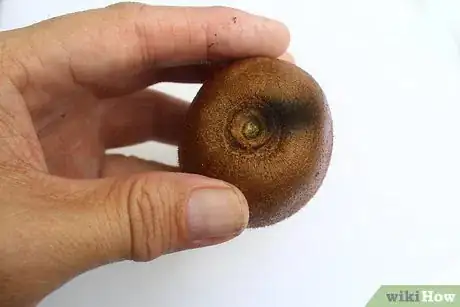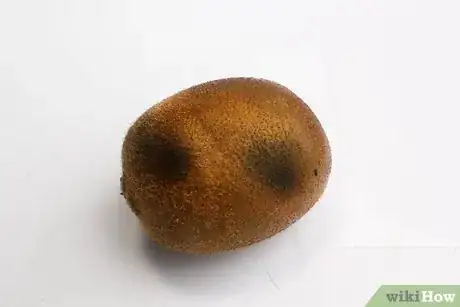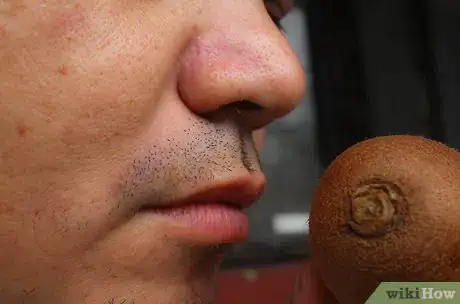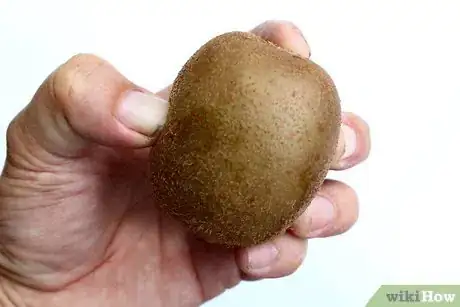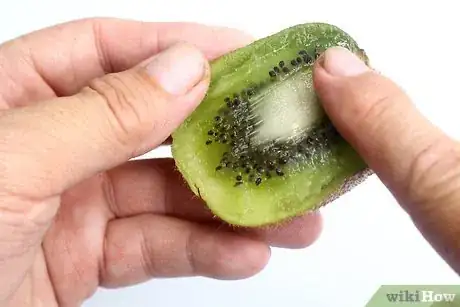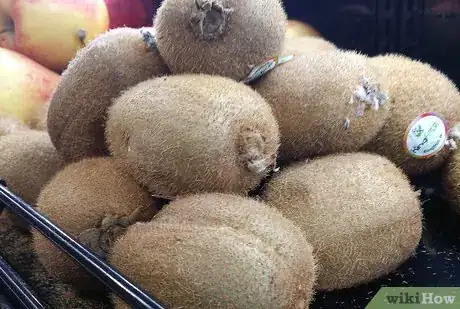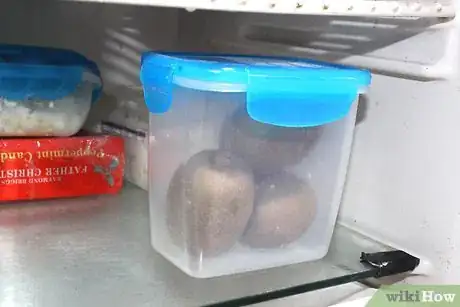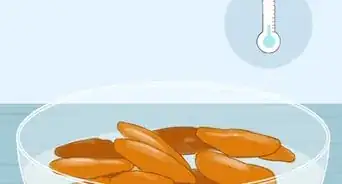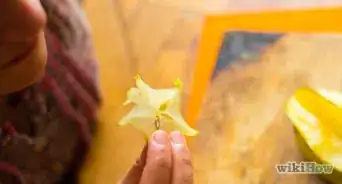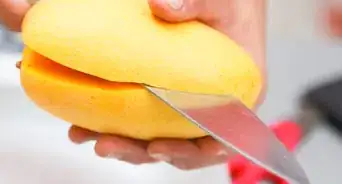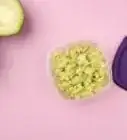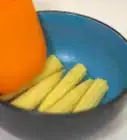This article was co-authored by wikiHow Staff. Our trained team of editors and researchers validate articles for accuracy and comprehensiveness. wikiHow's Content Management Team carefully monitors the work from our editorial staff to ensure that each article is backed by trusted research and meets our high quality standards.
This article has been viewed 188,145 times.
Learn more...
With their distinct brown skin and sweet, green pulp, kiwis are delicious in fruit salads, breakfast smoothies, or just on their own. You may get kiwis from your local grocery store or farmer’s market and wonder if they are still fresh or good a few days later. To determine if a kiwi has gone bad, examine the kiwi for mold. You can also smell and touch it to determine its freshness. To prevent your kiwis from going bad in the future, make sure you ripen it properly at home.
Steps
Examining the Kiwi
-
1Check the skin and pulp for mold. Pick up the kiwi and look at it closely for patches of brown or green mold. The mold may appear fuzzy, with flecks of white on the skin or pulp of the fruit.[1]
- There may be patches of mold all over the kiwi or on just one area. Because kiwis are so small, it’s best to throw away moldy ones rather than try to cut off the mold and eat the non-moldy area.
-
2Notice if the skin or pulp looks dry. Notice if the skin of the kiwi looks shriveled and dry. The pulp may also look dull and dry, with little to no juice in the pulp. These are signs that kiwi may have gone bad.[2]Advertisement
-
3Check the kiwi for mushy patches. You can also examine the kiwi for any parts that look wet or mushy, especially on the skin. This may be a sign that the kiwi is spoiled.
Smelling and Touching the Kiwi
-
1Sniff the kiwi for an acidic smell. Kiwis that have gone bad will have an off, slightly acidic smell. Sniff the kiwi’s skin and pulp to determine if it has an unpleasant smell. If so, it has likely spoiled.[3]
- A fresh kiwi will smell citrusy and light, with a touch of sweetness.
-
2Squeeze the kiwi to see if it is hard or mushy. Use your fingers to gently squeeze the kiwi. If it is very hard to the touch, it was likely underripe when you got it and may need more time to ripen, or it may just be bad. If the kiwi is very mushy to the touch, it has gone bad.[4]
- If the kiwi is very hard, you can try ripening it on your kitchen counter next to a banana or apple for a few days to see if it softens and ripens.
-
3Touch the pulp to see if it is dry. Use your finger to carefully press on the pulp in the kiwi. If it is dry to the touch, the kiwi has likely gone bad.
- If the kiwi is soft to the touch and appears juicy, it might be okay to eat as long as it does not smell bad or have mold on it.
Ripening a Kiwi Properly
-
1Buy kiwis when they are in season. Most kiwis are imported from New Zealand or Chile, and their growing season is May to November. Look for kiwis at your local grocery store during this time to ensure you buy the best kiwis possible. Buying kiwis in season will ensure they are ripe and juicy.[5]
- Kiwis sold from December to April were likely picked before they were ripe and will not ripen properly when you bring them home.
-
2Leave an unripe kiwi on the counter next to bananas or apples. Bananas and apples are high in ethylene, so they accelerate the ripening of any fruits they are close to. You can put a kiwi and a banana together in a paper bag to speed up ripening, or simply place the kiwi next to a banana or an apple in a fruit bowl on your counter.[6]
- You can also leave kiwis next to tomatoes, apricots, figs, cantaloupe, avocados, pears, and peaches to help them ripen faster.
-
3Put a ripe kiwi in the fridge to keep it fresh. Once the kiwi feels soft to the touch and smells fragrant, you can put it in the fridge to slow down its ripening process. If you have a ripe kiwi that is cut in half, wrap it in plastic or foil and put it in the fridge. You can also store cut kiwi in an airtight plastic container in the fridge.[7]
- Ripe kiwis usually last three to four days in the refrigerator.
Community Q&A
-
QuestionWhat would an already-cut bad kiwi look like?
 Community AnswerIf you see darker green, mushier spots inside the kiwi, it's gone bad.
Community AnswerIf you see darker green, mushier spots inside the kiwi, it's gone bad. -
QuestionHas the kiwi gone bad if it smells alcohol?
 Allison SchickTop AnswererIf a kiwi's smell is off at all, then it most likely has gone bad. I would throw it out.
Allison SchickTop AnswererIf a kiwi's smell is off at all, then it most likely has gone bad. I would throw it out. -
QuestionWhat does it mean if a kiwi has two small white spots, but doesn't smell bad?
 Community AnswerIt's probably a little mold. You can choose to cut that part out and eat the rest, or throw away the whole kiwi; it's up to you. If the mold is on the inside of an already-cut kiwi, it would probably be safer just to throw the kiwi away; mold can spread quickly inside the soft and wet inside of a kiwi.
Community AnswerIt's probably a little mold. You can choose to cut that part out and eat the rest, or throw away the whole kiwi; it's up to you. If the mold is on the inside of an already-cut kiwi, it would probably be safer just to throw the kiwi away; mold can spread quickly inside the soft and wet inside of a kiwi.
References
- ↑ http://www.stilltasty.com/Fooditems/index/17481
- ↑ http://www.friedas.com/karensblog/my-frustrating-kiwifruit-experience/
- ↑ http://www.stilltasty.com/Fooditems/index/17481
- ↑ http://www.friedas.com/karensblog/my-frustrating-kiwifruit-experience/
- ↑ http://www.friedas.com/karensblog/my-frustrating-kiwifruit-experience/
- ↑ https://spoonuniversity.com/lifestyle/food-going-bad
- ↑ http://www.stilltasty.com/Fooditems/index/17481
About This Article
To tell if a kiwi has gone bad, examine it for mold, dryness, or mushy spots. Look closely at the kiwi for patches of brown or green mold, which might appear fuzzy with flecks of white on the skin or pulp of the fruit. Since kiwis are so small, it’s best to throw them away rather than try to cut off the moldy part and eat the remaining fruit. Another way to tell if your kiwi is bad is to see if the skin looks shriveled or dry or if there’s little or no juice in the pulp. Alternatively, if the kiwi has patches that look wet or mushy, especially on the skin, it’s likely a sign that the kiwi is spoiled. To learn how to tell if a kiwi has gone bad by smelling it, keep reading!

